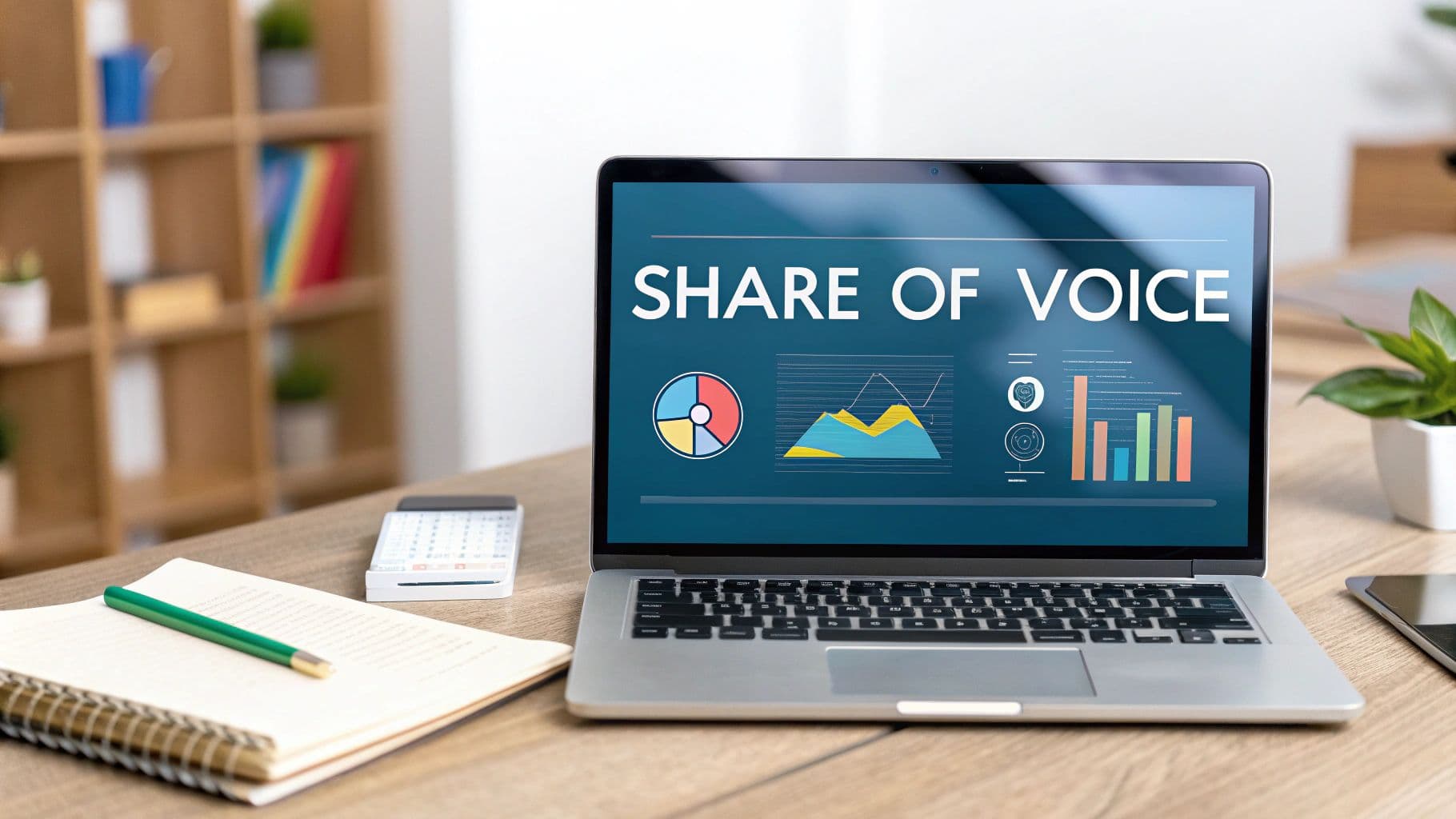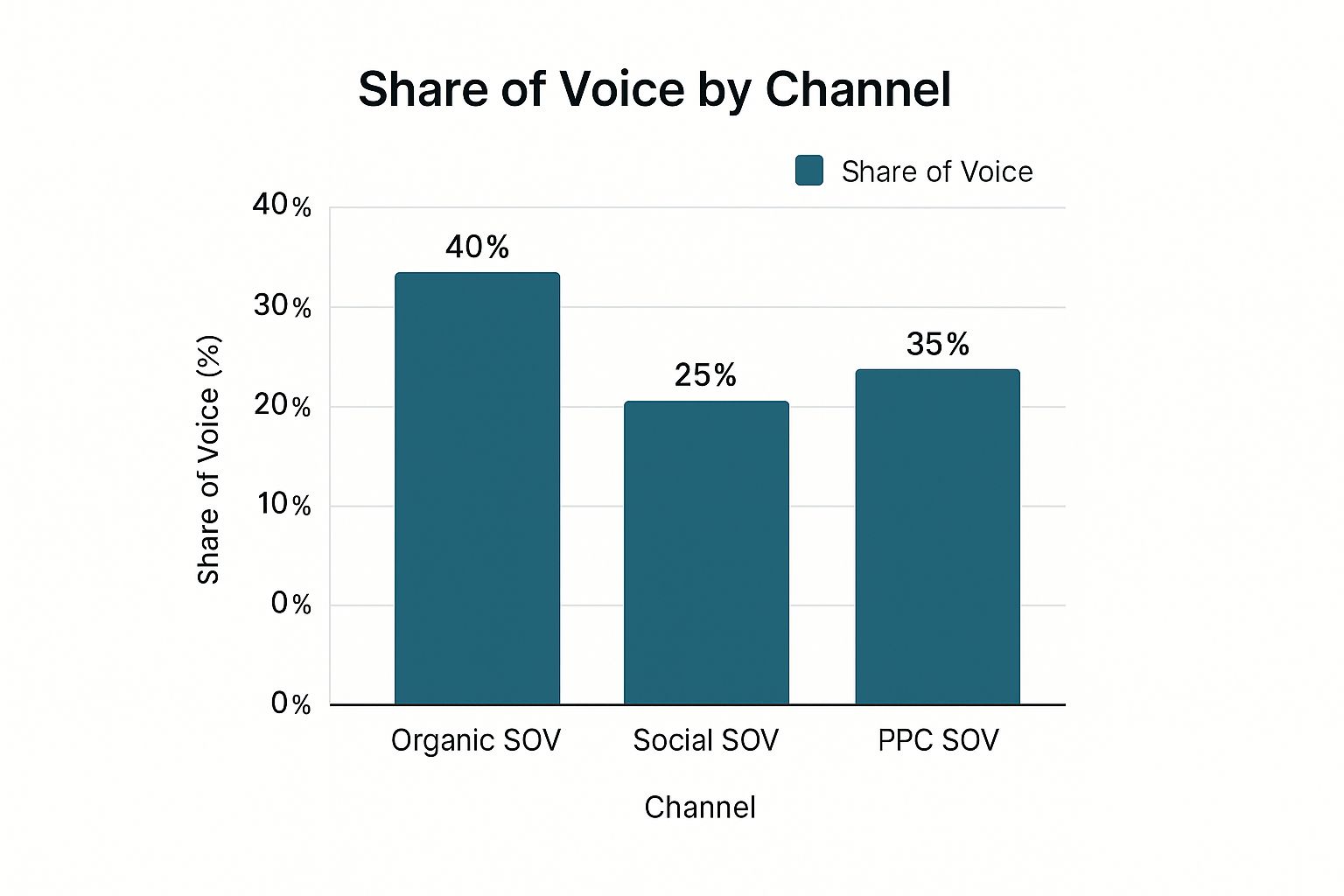
Calculating share of voice isn't some abstract marketing theory. It’s a number you can track. For us founders, it's about one thing: figuring out how much of the conversation we actually own in the places that matter.
The formula is dead simple: Your Brand Mentions / Total Mentions in Your Market.
That’s it. That’s what turns "share of voice" from a buzzword into a KPI you can actually improve. Here's exactly how we do it at BillyBuzz.
Defining Your Battlefield Before You Measure Anything

Before you touch a spreadsheet, you have to decide where you're fighting and who you're fighting against. If you don't, you’ll end up with a useless, vanity metric. Are you measuring brand mentions on Reddit? Organic visibility for 10 keywords? Ad impressions in one niche? You have to define the scope.
At BillyBuzz, we don't measure everything. We only focus on the channels where conversations directly lead to customers.
Choosing Your Arena
First, pick your channels. When we were just starting, our entire world was Reddit. We defined our "market" as five subreddits: r/saas, r/marketing, r/growmybusiness, r/Entrepreneur, and r/startups. We ignored everything else.
This made our SOV calculation simple: how many times was BillyBuzz mentioned vs. our top two competitors in those five subreddits? That was the entire metric.
As we've grown, our scope has expanded to:
- Organic Keywords: A basket of 20 non-branded keywords our ideal customers use.
- Social Mentions: Our brand name (and misspellings) vs. competitors on X (formerly Twitter).
- Media Presence: Mentions in a curated list of 15 industry blogs.
My advice: Start tiny. Pick one channel where winning the conversation would change your business. Master SOV there before you even think about expanding.
Identifying True Competitors
Who you measure against is just as important. Don't list Google or HubSpot as your competitors. It skews the data and makes your SOV look pathetic. It's demoralizing and useless.
We have a simple process for this, which we break down in our guide on how to conduct a competitor analysis for emerging businesses. We focus only on direct competitors—startups at a similar stage, chasing the same customers. This gives us an SOV that reflects a battle we can actually win.
In today's world, Share of Voice isn’t just ad spend. A brand could have a 40% SOV in social media mentions but only a 15% share of organic search traffic. That gap is a massive, blinking sign telling you where to focus your energy next. This is why defining your scope is the most important step.
The 4 Formulas We Actually Use to Calculate SOV
Let's cut the fluff. Calculating share of voice isn't art; it’s just applying simple formulas to the right numbers.
At BillyBuzz, we use four core equations for the channels that drive our growth. This isn't theory; it’s the math we run internally for organic search, social media, paid ads, and media mentions.
Organic SOV Based on Keyword Rankings
Organic search is a huge piece of the puzzle. To calculate our SOV here, we measure our visibility across a specific group of keywords versus our competitors. It’s not about if you rank, but how many clicks those rankings get you.
The formula: (Your Brand's Estimated Clicks / Total Estimated Clicks for All Tracked Keywords) x 100
We define our core keyword set, then use a tool to estimate search volume and the likely click-through rate (CTR) for each position. If we rank #1 for a keyword with 1,000 monthly searches, we estimate ~280 clicks (a 28% CTR). We add up our estimated clicks and divide by the total potential clicks across our defined competitors.
Social SOV Based on Brand Mentions
This is our bread and butter. It’s a direct pulse on brand chatter and tells us how much of the conversation we own on platforms like Reddit and X.
The formula we live by: (Your Brand Mentions / Total Market Mentions) x 100
"Total Market Mentions" is simply your mentions plus your key competitors' mentions. If BillyBuzz gets 80 mentions in a week, and our two main rivals get 60 each, the total market is 200 mentions. Our social SOV is (80 / 200) x 100 = 40%. Simple and powerful.
The chart below shows how SOV can differ across channels, highlighting where a brand’s voice is strongest.

You can see at a glance that while Organic SOV is strong at 40%, there's a clear opportunity to increase our volume on social channels.
PPC SOV Based on Impression Share
For paid ads, the metric is built right into platforms like Google Ads. It’s called Impression Share, and it’s the cleanest way to measure paid SOV.
The calculation: (Your Ad Impressions / Total Eligible Ad Impressions) x 100
If your ads were shown 1,000 times out of a possible 10,000 impressions, your Impression Share—and your PPC SOV—is 10%. It tells you exactly how much paid search territory you own.
Founder Tip: Don't chase a perfect, complex formula. A directionally correct metric you track consistently is infinitely better than a "perfect" one you calculate once and forget about.
Media SOV Based on Editorial Mentions
Finally, we track mentions in trade publications and industry blogs. This shows us our PR and earned media footprint.
The formula is identical to social SOV, just with a different data source: (Your Media Mentions / Total Market Media Mentions) x 100
We maintain a list of 20-30 key industry sites and use alerts to track how often our name—and our competitors'—appears. It's a clear signal of our brand's authority.
To make this easier, here's our internal cheat sheet.
BillyBuzz's Share of Voice Calculation Cheat Sheet
A quick reference for the formulas, data, and tools we use to calculate SOV.
| SOV Type | Formula | Required Data | Our Go-To Tool |
|---|---|---|---|
| Organic SOV | (Your Clicks / Total Clicks) x 100 | Keyword rankings, search volume, CTR data | Ahrefs or Semrush |
| Social SOV | (Your Mentions / Total Mentions) x 100 | Brand & competitor social media mentions | BillyBuzz, of course! |
| PPC SOV | (Your Impressions / Total Impressions) x 100 | Impression Share data from ad platform | Google Ads |
| Media SOV | (Your Mentions / Total Mentions) x 100 | Brand & competitor mentions in articles | Google Alerts |
The key is picking a method and sticking with it for consistent tracking.
How We Actually Track Social SOV (Our Internal Setup)

The formulas are useless without good data. The real secret is building a listening engine that feeds them. This is a founder-to-founder look at our exact setup. It’s about being scrappy and effective.
Our BillyBuzz Alert & Filter Configuration
We live on Reddit and X. That’s where the real conversations in our niche happen. We use our own tool, BillyBuzz, to create hyper-specific alert rules that go way beyond just our brand name.
Here’s a look at the actual keyword strings we track inside BillyBuzz:
- Brand:
("BillyBuzz" OR "Billy Buzz" OR "BillyBuz") - Competitors:
("Competitor A" OR "Competitor B") - Problem-Based:
("track reddit mentions" OR "find customers on reddit" OR "social listening tools for reddit") - Use-Case:
("how to get feedback from reddit" OR "validate startup idea reddit") - VS. Keywords:
("BillyBuzz vs Competitor A" OR "Competitor A alternative")
We apply these keywords only to specific subreddits like r/saas, r/marketing, and r/growmybusiness. We also have a rule: Filter out posts with less than 2 upvotes. This simple filter saves us hours of sifting through junk every week.
For a deeper dive, we laid out our process in this guide on setting up real-time social media alerts.
Don't just track your brand name. People rarely mention you when describing a problem. Monitor their pain points to find conversations before your competitors do.
Our Response Templates (Steal These)
When an alert hits, speed and tone are everything. We have a few core response templates we adapt. The goal is always: be helpful first, promotional second.
If someone gives us a shoutout:
"Hey [Username], thanks for the mention! Glad you're finding it useful. We're always shipping new features, so any feedback is gold for us."
For negative feedback or a bug:
"Hi [Username], founder here. Sorry you're running into this—definitely not the experience we want. Mind if I DM you to get this sorted out personally?"
When someone describes a problem we solve (but doesn't mention us):
"This is a common struggle. A few things that help are [Tip 1] and [Tip 2]. We actually built a tool to automate this process because we were tired of doing it manually. No pressure to check it out, but it might save you some time."
This approach shows lurking prospects that we're founders who actually care. To do this right, you need a good grasp of social media analytics to interpret the data.
Historically, SOV was just ad spend. If the total ad market was $100 million and you spent $5 million, your SOV was 5%. We just adapted that same logic for the conversations that actually drive growth for a startup today.
Measuring SEO and Content Share of Voice

For us, organic search is a major battleground. Tracking individual keyword rankings is fine, but it doesn't tell the whole story. A #5 ranking is a world away from the #1 spot in terms of actual traffic.
To understand your real share of voice in search, you have to measure your slice of the visibility and potential clicks.
Building Your Keyword Basket
First, define your turf. We create a "keyword basket"—a curated list of non-branded terms our target users search for. For BillyBuzz, this includes "reddit lead generation" and "track brand mentions on reddit."
We keep this list tight—around 20-30 core keywords. The key is to resist adding broad, high-volume terms that don't signal intent. This isn't about ranking for everything; it's about owning the queries that lead to customers.
Once the basket is set, we identify our top three direct competitors who are also targeting these terms.
Applying a Weighted Formula
With keywords and competitors defined, we use a tool like Ahrefs to pull ranking data. But we don't just count rankings. We apply a weighted formula that factors in the average click-through rate (CTR) for each SERP position.
A #1 position might get a 28% CTR, while #3 is closer to 10%. Our formula reflects this:
- (Your Estimated Clicks / Total Estimated Clicks for All Competitors) x 100
To get "estimated clicks," we multiply a keyword's monthly search volume by the average CTR for our ranking position. We do this for every keyword, sum our total estimated clicks, and compare it against the total available clicks across all competitors.
Founder-to-Founder Tip: This weighted method is a game-changer. It stops you from celebrating a page-one ranking that gets no traffic. It forces you to focus on the positions that actually drive clicks.
This calculation gives us a real SOV percentage for our SEO efforts. It's a measure of our true share of search traffic, not just rankings.
As Reddit becomes more dominant in Google search, it's critical to see how community conversations impact this SOV. Learning how to turn Reddit threads into evergreen SEO has become a core part of our strategy to capture more of that voice.
Turning SOV Data Into a Growth Strategy
https://www.youtube.com/embed/QKMh2ca1wjc
Calculating your share of voice is pointless if the numbers just sit in a spreadsheet. The real value comes when you turn the data into a growth plan. It’s about moving from "what" to "so what?"
This is where Extra Share of Voice (ESOV) comes in. The concept is simple: your share of voice should be higher than your share of the market. Aiming for an SOV that’s 10 percentage points higher than your market share is a reliable benchmark for growth.
The data backs this up. A landmark study showed that a brand’s market share will grow by 0.5% for every 10% of ESOV it maintains. This creates a direct link between how much you’re talked about and how much you sell. This Nielsen analysis is a great read on the relationship.
Real-World Example: From Insight to Action
A few months ago, our Social SOV on Reddit dropped by nearly 15% in one quarter. The numbers were clear, but they didn't tell us why.
We dug into the raw mention data. A direct competitor had launched a content series targeting pain points in our key subreddits. They were publishing helpful guides and answering specific questions. Their voice was louder because it was more valuable.
Here’s the counter-play we ran:
- We Found Their Blind Spots: We analyzed their posts to find topics they weren't covering.
- We Launched a "Founder AMA" Series: We started proactive threads in
r/saasandr/marketing, offering direct advice on those uncovered topics. - We Built Counter-Content: We wrote two blog posts that directly answered the most common follow-up questions from those AMAs, giving us our own high-value assets to share.
The result? Within six weeks, we had regained all our lost share of voice, plus some. That's how you make SOV data actionable. Diagnose the threat, understand their strategy, and launch a smarter response.
Don't just track the percentage; track the narrative. A sudden drop in SOV means a competitor is telling a better story. Your job is to figure it out and write a more compelling one.
At the end of the day, improving your Share of Voice helps you figure out how to increase website traffic and build a brand that's harder to ignore.
Your SOV Questions, Answered
As founders, we get a lot of questions about share of voice. Here are the most common ones, with direct answers from our own experience building BillyBuzz.
How often should I calculate SOV?
The right cadence depends on the channel. Tracking everything daily is a waste of time. Here’s our internal schedule:
- Social SOV (Reddit & X): Weekly. Social moves fast. A weekly snapshot gives us current sentiment without getting lost in daily noise.
- SEO & Content SOV: Monthly. Search rankings don't change dramatically overnight. A monthly check-in gives our strategies time to show an impact.
- Media Mentions: Quarterly. Earned media hits are less frequent but have a longer shelf life. A quarterly review spots broader PR trends.
What is a good share of voice percentage?
There's no magic number. A "good" SOV is relative to your market and stage. When we started, hitting 10% felt like a huge win.
The most important benchmark isn't an industry standard; it's your own progress. Is it trending up? Then you're doing something right.
Strategically, aim for an SOV that's higher than your market share. This concept, Extra Share of Voice (ESOV), drives growth. We aim to keep our SOV about 10-15 points ahead of our estimated market share.
Which tools are best for a startup budget?
You don't need an enterprise suite. For a long time, we ran on a few lean tools.
- For Social Mentions: We built BillyBuzz for this. Before that, we used hyper-specific Google Alerts and manually checked key subreddits. It works.
- For SEO SOV: A basic plan from Ahrefs or Semrush is worth every penny for the competitor keyword data you get.
- For Media Mentions: Google Alerts is your best friend. It’s free. Set it up for your brand, competitors, and key industry terms.
How do I track SOV for podcasts or videos?
This is still the wild west. There isn't a great, automated tool for this.
Our approach is manual. We identified the top 10-15 podcasts and YouTube channels in our niche. We then manually check their show notes and transcripts for mentions of our brand and competitors. It’s a grind, but for a focused set of channels, it gives us a directional sense of our voice there.
Ready to stop guessing and start calculating your share of voice on the platform that matters most? BillyBuzz uses AI to find high-intent conversations on Reddit, so you can engage new customers and grow your brand. See how BillyBuzz works.
